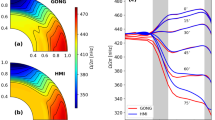Abstract
We present extensive numerical calculations for a model of thermal convection of a Boussinesq fluid in an equatorial annulus of a rotating spherical shell. The convection induces and maintains differential rotation and meridian circulation. The model is solved for an effective Prandtl number P = 1, with effective Taylor number T in the range 102 <T <106, and effective Rayleigh number R between the critical value for onset of convection, and a few times that value. With Ω = 2.6 × 10−6 s−1, d = 1.4 × 1010 cm (roughly the depth of the solar convection zone) the range of Taylor number is equivalent to kinematic viscosities between 1014 and 1012 cm2 s−1, which encompasses eddy viscosities estimated from mixing length theory applied to the Sun.
The convection does generally make equatorial regions rotate faster, the more so as T is increased, but local equatorial deceleration near the surface is also produced at intermediate T for large enough R above critical. The differential rotation is maintained primarily through momentum transport in the cells up the gradient, rather than by meridian circulation. Differential rotation energy increases relative to cell energy with increasing T, surpassing it near T = 3 × 104. The differential rotation tends to stretch out the convective cells, analogously to what is thought to happen to solar magnetic regions. Differential rotation and meridian circulation energies are nearly equal for T = 103, but the meridian circulation energy falls off relative to differential rotation like T −1 for larger T. The meridian circulation is always toward the poles near the surface, contrary to models of Kippenhahn, Cocke, Köhler, and Durney and Roxburgh. The radial shear produced in the differential rotation is almost always positive, as in the Köhler model, but contrary to the assumptions made by Leighton for his random walk solar cycle model.
Solutions in the neighborhood of T = 3 × 104 seem to compare best with various solar observations including differential rotation amplitude, cell wavelength, tilted structure, horizontal momentum transport, and weak meridian circulation. The local equatorial deceleration (equatorward of 10–15°) has not been observed, although the techniques of data analysis may not have been sensitive to it. The most important deficiency of the model is that all the solutions with T⩾ 103 show the vertical heat transport a rather strong function of latitude, with a maximum at the equator, no evidence of which is seen at the solar surface.
Similar content being viewed by others
References
Allen, C. W.: 1955, Astrophysical Quantities, University of London, Athlone Press, p. 291.
Bumba, V. and Howard, R.: 1965, Astrophys. J. 141, 1502.
Busse, F.: 1970a, Astrophys. J. 159, 629.
Busse, F.: 1970b, J. Fluid Mech. 44, 441.
Chandrasekhar, S.: 1961, Hydrodynamic and Hydromagnetic Stability, Oxford, London, p. 652.
Cocke, W. J.: 1967, Astrophys. J. 150, 1041.
Davies-Jones, R. P.: 1971, J. Fluid Mech. 49, 193.
Davies-Jones, R. P. and Gilman, P. A.: 1970, Solar Phys. 12, 3.
Davies-Jones, R. P. and Gilman, P. A.: 1971, J. Fluid Mech. 46, 65.
Durney, B.: 1968, J. Atmospheric Sci. 25, 372.
Durney, B.: 1970, Astrophys. J. 161, 1115.
Durney, B.: 1971, Astrophys. J. 163, 353.
Durney, B. and Roxburgh, I. W.: 1971, Solar Phys. 16, 3.
Gilman, P. A.: 1969a, Solar Phys. 8, 316.
Gilman, P. A.: 1969b, Solar Phys. 9, 3.
Heard, W. B.: 1972, Ph.D. Thesis, submitted to Dept. of Astronomy, Yale University.
Howard, R.: 1971, Solar Phys. 16, 21.
Howard, R. and Harvey, J.: 1970, Solar Phys. 12, 23.
Kato, S.: 1969, Astrophys. J. 157, 827.
Kato, S. and Nakagawa, Y.: 1969, Solar Phys. 10, 476.
Kippenhahn, R.: 1963, Astrophys. J. 137, 664.
Köhler, H.: 1970, Solar Phys. 13, 3.
Leighton, R. B.: 1964, Astrophys. J. 140, 1559.
Leighton, R. B.: 1969, Astrophys. J. 156, 1.
Lilly, D. K.: 1967, Proceedings IBM Scientific Computing Symposium on Environmental Sciences, p. 195.
Lipps, F. B. and Sommerville, R. C. T.: 1971, Phys. Fluids 14, 759.
Phillips, N. A.: 1959, in The Atmosphere and the Sea in Motion, Rockefeller Inst. Press and Oxford Univ. Press.
Plaskett, H. H.: 1966, Monthly Notices Roy. Astron. Soc. 131, 407.
Roberts, P. H. and Stix, M.: 1971, NCAR Technical Note, No. IA-60, National Center for Atmospheric Research, Boulder, Colo. 80302.
Simon, G. and Weiss, N. O.: 1968, Z. Astrophys. 69, 435.
Starr, V. P. and Gilman, P. A.: 1965, Tellus 17, 334.
Unno, W.: 1961, Publ. Astron. Soc. Japan 13, 276.
Veronis, G.: 1963a, J. Marine Res. 21, 2.
Veronis, G.: 1963b, J. Marine Res. 21, 199.
Vickers, G. T.: 1971, Astrophys. J. 163, 363.
Ward, F.: 1964, Pure Appl. Geophys. 58, 157.
Ward, F.: 1965, Astrophys. J. 141, 534.
Weiss, N. O.: 1971, in R. Howard (ed.), ‘Solar Magnetic Fields’, IAU Symp. 43, 757.
Wilcox, J. M.: 1968, Space Sci. Rev. 8, 258.
Williams, G. P.: 1969, J. Fluid Mech. 37, 727.
Yoshimura, H.: 1971, Solar Phys. 18, 417.
Yoshimura, H. and Kato, S.: 1971, Publ. Astron. Soc. Japan 23, 57.
Author information
Authors and Affiliations
Additional information
The National Center for Atmospheric Research is sponsored by The National Science Foundation.
Rights and permissions
About this article
Cite this article
Gilman, P.A. Nonlinear boussinesq convective model for large scale solar circulations. Sol Phys 27, 3–26 (1972). https://doi.org/10.1007/BF00151765
Received:
Revised:
Issue Date:
DOI: https://doi.org/10.1007/BF00151765




